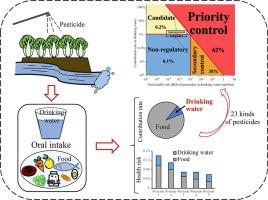Environment International ( IF 10.3 ) Pub Date : 2021-10-01 , DOI: 10.1016/j.envint.2021.106901 Chenhui Sang 1 , Zhiyong Yu 2 , Wei An 2 , Peter Borgen Sørensen 3 , Fen Jin 4 , Min Yang 5

|
Pesticides are pollutants of high concern in drinking water. Several approaches aimed to promote pesticide risk management in drinking water have been brought forward by diverse ways, however, these methods usually take too many indicators into consideration, which are complex and non-universal. In this study, a more focused and data driven ranking model was proposed for the purpose of development of the priority control list in drinking water. By determining three parameters including the total health risks of dietary exposure pathways, drinking water contribution rates, and the drinking water health risks, pesticides could be divided into four categories including the priority control list, secondary control list, candidate control list, and non-regulatory list. As a case study, the proposed model was implemented for 23 pesticides detected in drinking water from 36 major cities across China during two major science and technology program for water pollution control and treatment. Totally 13 kinds of pesticides including carbofuran, dicofol, chlorpyrifos, 2,4-D, acetochlor, deltamethrin, dimethoate, heptachlor, parathion, hexachlorobenzene, DDT, hexachlorocyclohexane and atrazine are selected for priority control, methyl parathion, dichlorvos and chlorothalonil are recommended for secondary control, butachlor and malathion are classified into candidate control list, and fenobucarb is suggested to be removed from the pesticide control list.











































 京公网安备 11010802027423号
京公网安备 11010802027423号